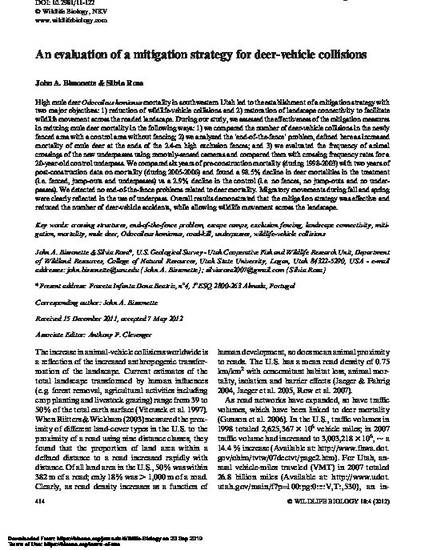
Article
Evaluation of a mitigation strategy for deer-vehicle collisions
Wildlife Biology
(2012)
Abstract
High mule deer Odocoileus hemionus mortality in southwestern Utah led to the establishment of a mitigation strategy with two major objectives: 1) reduction of wildlife-vehicle collisions and 2) restoration of landscape connectivity to facilitate wildlife movement across the roaded landscape. During our study, we assessed the effectiveness of the mitigation measures in reducing mule deer mortality in the following ways: 1) we compared the number of deer-vehicle collisions in the newly fenced area with a control area without fencing; 2) we analyzed the ‘end-of-the-fence’ problem, defined here as increased mortality of mule deer at the ends of the 2.4-m high exclusion fences; and 3) we evaluated the frequency of animal crossings of the new underpasses using remotely-sensed cameras and compared them with crossing frequency rates for a 20-year-old control underpass. We compared six years of pre-construction mortality (during 1998-2003) with two years of post-construction data on mortality (during 2005-2006) and found a 98.5% decline in deer mortalities in the treatment (i.e. fenced, jump-outs and underpasses) vs a 2.9% decline in the control (i.e. no fences, no jump-outs and no underpasses). We detected no end-of-the-fence problems related to deer mortality. Migratory movements during fall and spring were clearly reflected in the use of underpass. Overall results demonstrated that the mitigation strategy was effective and reduced the number of deer-vehicle accidents, while allowing wildlife movement across the landscape.
Disciplines
Publication Date
2012
DOI
https://doi.org/10.2981/11-122
Citation Information
John Bissonette. "Evaluation of a mitigation strategy for deer-vehicle collisions" Wildlife Biology Vol. 18 Iss. 4 (2012) p. 414 - 423 Available at: http://works.bepress.com/john_bissonette/367/
